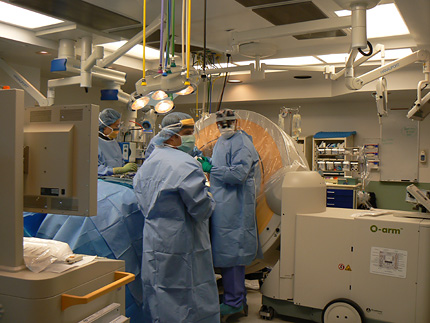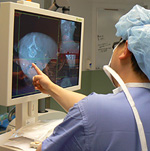
The UCSF Spine Center recently acquired a new imaging system that will assist surgeons in navigation techniques and help the center expand and enhance surgical procedures. The technology is the first of its kind in the western United States.
Called the O-arm Imaging System, the equipment provides complete, multi-dimensional surgical imaging. It provides surgeons with real-time, 3-D images, as well as multiplane, 2-D and fluoroscopic imaging. Coupling this system with other computer-assisted navigation equipment, UCSF surgeons can perform procedures with a higher rate of accuracy, potentially allowing them to successfully perform even more difficult and complex surgeries.
"Adding the O-arm to the Spine Center allows us to further streamline operating room efficiency and possibly improve patient outcomes," says Shane Burch, MD, orthopedic spine surgeon, UCSF Medical Center, and assistant professor of orthopedic surgery at UCSF.
According to Burch, complex spinal deformities make it very difficult to work on a patient. Using the more traditional X-ray equipment, UCSF surgeons had to take several, lesser-quality images of the patient, often having to move the patient and equipment into different positions to get the best view of the area of the spine they were working on.
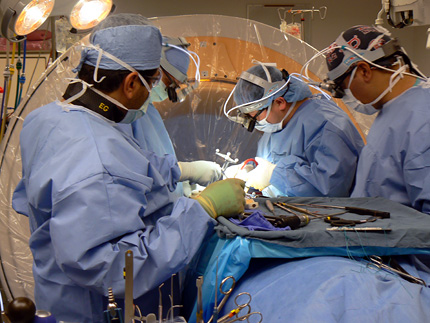 |
|
"Traditionally, we use anatomic landmarks to place screws in the spine, but each person's anatomy is different. There are differences in bone diameter, density and shape," explains Burch. "Because we are working within a very narrow channel of bone, there can be no margin of error. Computer-assisted surgical navigation will help us become even more accurate when implanting devices in the spine."
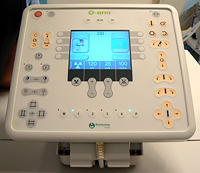 |
|
In addition to its use on patients with complex spinal anatomy, the imaging system will be used in more routine, minimally invasive surgical procedures, providing for smaller incisions and a reduction in surgery time.
A sterile surgical drape is placed around the arm of the system, which then goes around the patient and closes into a doughnut - or "O" - shape, taking a 360-degree image of the patient. The feature enables unrestricted views of the patient, yielding high-quality imaging comparable to fixed computed tomography (CT) systems. The images are displayed on two computer screens, providing surgeons with detailed images of a patient's anatomy.
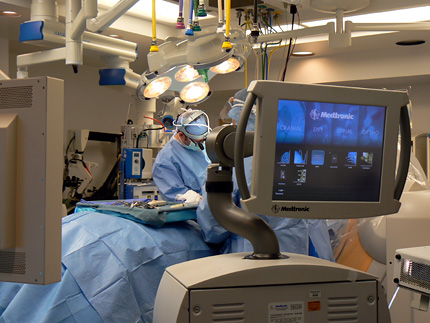 |
|
It also provides surgeons with a 3-D reconstruction of the area being examined, such as an area of the spine and surrounding tissue, which can be rotated in any direction and navigated virtually. Surgeons then use a pointer to place a mark on the screen where they plan to conduct the procedure. The computer calculates the necessary trajectory the surgeons will use. Because of the system's high rate of accuracy, Burch and colleagues expect to see a reduction in surgery time, as well as less radiation exposure for both medical staff and the patient.
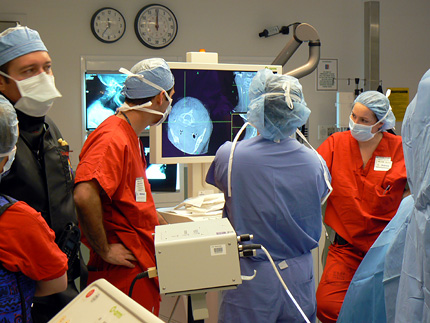 |
|
The O-arm Imaging System was created by Breakaway Imaging, and is marketed and distributed by Medtronic. The O-arm Imaging System received Food and Drug Administration clearance in 2005.
The UCSF Spine Center is one of the largest centers of its kind in the country, treating 10,000 patients a year. The center brings together world-renowned specialists in neurosurgery, orthopedic surgery, neurology, psychiatry and other specialties to design the most effective treatment for patients. The center treats the full spectrum of spinal disorders - from complex and difficult-to-diagnose conditions to those that have failed previous treatment - and is becoming a leader in minimally invasive procedures.
In addition to caring for patients, experts and researchers at the center are at the forefront of basic scientific research to better understand spinal conditions, as well as research to develop and test new technologies and treatments.
Related Links:
UCSF Spine Center
UCSF Spine Center: One-Stop Resource for Treatment of Complex Spinal Problems in Adults and Children
UCSF News Release, May 14, 2004





